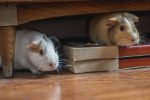Having a guinea pig as a pet must be fun. Guinea pigs are cute and easy to take care of so no wonder why many of us choose them to be the first pet. They might be small, but actually, guinea pigs are hardy and not as fragile as the rabbit. However, guinea pigs still need our attention in order to keep them happy and healthy. Not only food or diet plan, but another important thing that we need to prepare if we want to bring guinea pigs to our home is also to have a set up the cage for them. Don’t we all love to stay in a comfortable home? So do guinea pigs! Setting up a cage for guinea pigs should not be a complicated step, because this article will guide you on how to prepare that! Let’s get started, shall we?
How to Set Up Guinea Pig’s Cage, You Can Do It!
1. Choosing the proper cage
The first thing that you have to do is choosing the type of cage. There are so many types of them, but make sure you consider these stuff before deciding which one:
- The size of cage
Usually, guinea pigs need a cage that is at least 7.5 square feet, or you may want to pick a bigger one if you have more than two guinea pigs. Don’t worry, the cage cannot be too big for them, because guinea pigs love to run around their cage! They also like to popcorning. Have you ever heard that term? Popcorning is a unique behavior in guinea pigs when they repeatedly jump right into the air pr run back and forth quickly because they are extremely happy over something. This behavior is quite funny, so you may want to let them do it in a large and spacious cage.
- Do you need a hutch or cubes?
If you keep your guinea pigs outdoor, you may need a one-story hutch for them. Ideally, a hutch with an opening and built-in hut is enough for your guinea pigs. On the other hand, if you keep guinea pigs indoor, you may consider choosing cubes and coroplast cage one.
- Cage with a ramp
A ramp can be essential for guinea pigs’ cage. The suitable ramp for them must not be too steep and have a good grip to prevent your little friend from falling when they go up and down.
- Avoid aquariums
Despite how popular it was for a guinea pigs’ cage, aquariums type is actually not good enough for your little friend because it doesn’t have proper air circulation for your guinea pigs.
- Avoid a cage with a wire bottom
Guinea pigs have sensitive feet, so the best surface for your guinea pigs’ cage is the flat and solid bottom, not the wire bottom one. Wire bottom type may injure your guinea pigs’ feet!
2. The proper place to put the cage
After choosing the cage, now you have to choose the spot. You can put the cage anywhere, but make sure you consider this list before:
- Predator free
If you want to have guinea pigs at your home, make sure your home is predator-proof, which means, your guinea pigs’ cage must be kept in a safe and secure place, away from their predators, including dogs and cats.
- Ideal temperature
Guinea pigs are also sensitive to temperature fluctuation so you may want to put their cage in a spot with a back-up indoor cage during hotter or colder months peak. The room should not be too cold or too humid. Usually, guinea pigs live in a 65 to 75 degrees Fahrenheit temperatures.
- Psst, don’t be too noisy, please!
Besides temperature, guinea pigs are also sensitive to loud noise. They have very sensitive hearing, so a quiet room is way more suitable to put on their cage rather than a place next to a loud stereo, like television, for example.
3. Suitable bedding
There are many types of bedding for the guinea pig. The important thing is to make sure the materials are not toxic or may injure your little friend.
- Guinea pigs’ bedding that you have to avoid
Bedding materials like cedar, pine shaving, sawdust, and corncob is bad for your guinea pigs. Those type of bedding are actually toxic for your guinea pigs because it may lead to respiratory or any health problem and also injured their feet (remember that your guinea pigs have sensitive feet!) Newspaper and straw may be popular among the type of bedding, but those types are not good enough for guinea pigs. A newspaper, for example, cannot be the main bedding because it does not have enough absorbent. So does with straw, but even more, expensive, plus the long and rough texture straw type one may hurt your little friend’s feet!
- Suitable bedding for guinea pigs
The suitable material for your guinea pig’s bedding are vary from fleece, paper bedding, and hay. Fleece may require you to clean it up more often, but it’s safer for your guinea pigs’ health. Paper bedding packages made for guinea pigs can be easily found by you in pet stores and obviously safer but can make the cage a little bit smelly. If you cannot handle the smell, you may want to choose hay because this material has a good absorbent, natural, safe, and can control the smell. Just make sure the hay is thin, soft, and short enough so it will not hurt their feet. Whatever type that you choose, make sure you clean it up regularly to maintain the hygiene.
That’s all on what you have prepared for your guinea pigs. That’s not too much, right? Setting up the cage for your guinea pigs is important so your little friends can stay in their cage comfortably. You also want to make sure they are safe and healthy, don’t you? Good luck with having guinea pigs as your pet!

